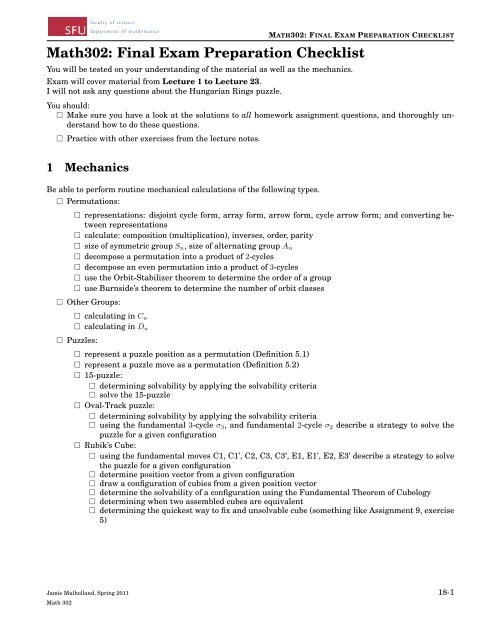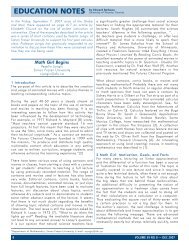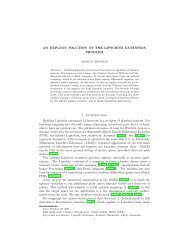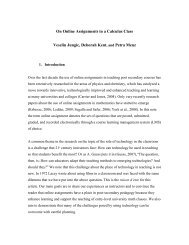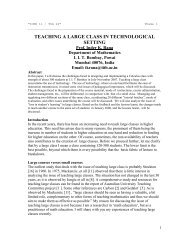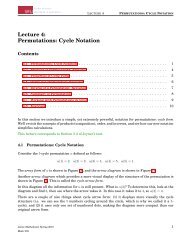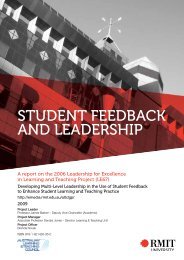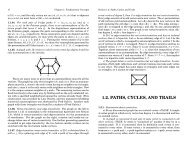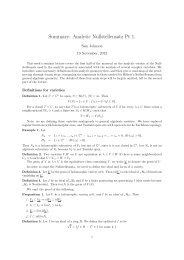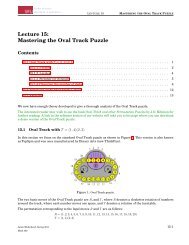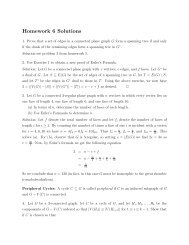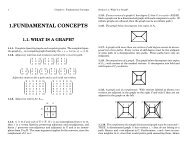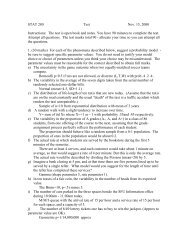Math302: Final Exam Preparation Checklist - People.stat.sfu.ca
Math302: Final Exam Preparation Checklist - People.stat.sfu.ca
Math302: Final Exam Preparation Checklist - People.stat.sfu.ca
You also want an ePaper? Increase the reach of your titles
YUMPU automatically turns print PDFs into web optimized ePapers that Google loves.
Week Date Sections<br />
from FS2009<br />
Part/ References Topic/Sections Notes/Speaker<br />
1 Sept 7 I.1, I.2, I.3 Combinatorial Symbolic methods<br />
2 14 I.4, I.5, I.6<br />
Structures<br />
FS: Part A.1, A.2<br />
Unlabelled structures<br />
3 21 II.1, II.2, II.3<br />
Comtet74<br />
Handout #1<br />
Labelled structures I<br />
4 28 II.4, II.5, II.6<br />
(self study)<br />
Labelled structures II<br />
5 Oct 5 III.1, III.2<br />
Combinatorial<br />
parameters<br />
FS A.III<br />
Combinatorial<br />
Parameters<br />
6 12 IV.1, IV.2 (self-study)<br />
Multivariable GFs<br />
Asst #1 Due<br />
7 19 IV.3, IV.4 Analytic Methods Complex Analysis<br />
8<br />
9<br />
26<br />
Nov 2<br />
IV.5 V.1<br />
FS: Part B: IV, V, VI<br />
Appendix B4<br />
Stanley 99: Ch. 6<br />
Handout #1<br />
Singularity Analysis<br />
Asymptotic methods<br />
Asst #2 Due<br />
9 VI.1<br />
10 Permutations:<br />
(self-study)<br />
Sophie<br />
12 A.3/ C<br />
Introduction to Prob. Mariolys<br />
11<br />
12<br />
f aculty of science MATH 895-4 Fall 2010<br />
department of mathematics Course Schedule MATH302: FINAL EXAM PREPARATION CHECKLIST<br />
<strong>Math302</strong>: <strong>Final</strong> <strong>Exam</strong> <strong>Preparation</strong> <strong>Checklist</strong><br />
You will be tested on your understanding of the material as well as the mechanics.<br />
<strong>Exam</strong> will cover material from Lecture 1 to Lecture 23.<br />
I will not ask any questions about the Hungarian Rings puzzle.<br />
You should:<br />
Make sure you have a look at the solutions to all homework assignment questions, and thoroughly understand<br />
how to do these questions.<br />
Practice with other exercises from the lecture notes.<br />
1 Mechanics<br />
Be able to perform routine mechani<strong>ca</strong>l <strong>ca</strong>lculations of the following types.<br />
representations: disjoint cycle form, array form, arrow form, cycle arrow form; and converting between<br />
representations<br />
<strong>ca</strong>lculate: composition (multipli<strong>ca</strong>tion), inverses, order, parity<br />
size of symmetric group Sn, size of alternating group An<br />
decompose a permutation into a product of 2-cycles<br />
decompose an even permutation into a product of 3-cycles<br />
18 IX.1 Limit Laws and Comb Marni<br />
20 IX.2 Random Structures<br />
and Limit Laws<br />
Discrete Limit Laws Sophie<br />
23 IX.3<br />
FS: Part C<br />
(rotating<br />
presentations)<br />
Combinatorial<br />
instances of discrete<br />
Mariolys<br />
25 IX.4 Continuous Limit Laws Marni<br />
Quasi-Powers and<br />
13 30 use IX.5the<br />
Orbit-Stabilizer theorem Sophie<br />
Gaussian to limit determine laws the order of a group<br />
use Burnside’s theorem to determine the number of orbit classes<br />
14 Dec 10 Presentations Asst #3 Due<br />
Other Groups:<br />
<strong>ca</strong>lculating in Cn<br />
<strong>ca</strong>lculating in Dn<br />
Puzzles:<br />
represent a puzzle position as a permutation (Definition 5.1)<br />
represent a puzzle move as a permutation (Definition 5.2)<br />
15-puzzle:<br />
determining solvability by applying the solvability criteria<br />
solve the 15-puzzle<br />
Oval-Track puzzle:<br />
determining solvability by applying the solvability criteria<br />
using the fundamental 3-cycle σ3, and fundamental 2-cycle σ2 describe a strategy to solve the<br />
puzzle for a given configuration<br />
Rubik’s Cube:<br />
using the fundamental moves C1, C1’, C2, C3, C3’, E1, E1’, E2, E3’ describe a strategy to solve<br />
the puzzle for a given configuration<br />
determine position vector from a given configuration<br />
draw a configuration of cubies from a given position vector<br />
determine the solvability of a configuration using the Fundamental Theorem of Cubology<br />
determining when two assembled cubes are equivalent<br />
determining the quickest way to fix and unsolvable cube (something like Assignment 9, exercise<br />
5)<br />
Dr. Marni MISHNA, Department of Mathematics, SIMON FRASER UNIVERSITY<br />
Version of: 11-Dec-09<br />
Jamie Mulholland, Spring 2011<br />
Math 302<br />
18-1
Week Date Sections Part/ References Topic/Sections Notes/Speaker<br />
2 Definitions<br />
from FS2009<br />
1 Sept 7 I.1, I.2, I.3 Combinatorial Symbolic methods<br />
2 14 I.4, I.5, I.6<br />
Structures<br />
FS: Part A.1, A.2<br />
Unlabelled structures<br />
3 21 II.1, II.2, II.3<br />
Comtet74<br />
Handout #1<br />
Labelled structures I<br />
4 28 II.4, II.5, II.6<br />
(self study)<br />
Labelled structures II<br />
Combinatorial<br />
5 sets, Oct 5 functions, III.1, III.2 and parameters relations<br />
FS A.III<br />
Combinatorial<br />
Parameters<br />
6 12 IV.1, IV.2 (self-study)<br />
Multivariable GFs<br />
Asst #1 Due<br />
7<br />
8<br />
9<br />
19 IV.3, IV.4 Analytic Methods Complex Analysis<br />
relation on aFS: set Part B: IV, V, VI<br />
26<br />
Singularity Analysis<br />
Appendix B4<br />
IV.5 reflexive, V.1 symmetric, transitive<br />
Stanley 99: Ch. 6<br />
Nov 2 equivalence Handout relation #1<br />
Asymptotic methods<br />
Asst #2 Due<br />
9 VI.1 equivalence (self-study) class<br />
Sophie<br />
10<br />
12<br />
equivalence class representative<br />
A.3/ C<br />
Introduction to Prob. Mariolys<br />
11<br />
12<br />
18 IX.1 Limit Laws and Comb Marni<br />
20 IX.2 Random Structures Discrete Limit Laws Sophie<br />
and Limit Laws<br />
permutation of a set X<br />
FS: Part C<br />
23 IX.3<br />
(rotating<br />
presentations)<br />
Combinatorial<br />
instances of discrete<br />
Mariolys<br />
25 IX.4 Continuous Limit Laws Marni<br />
13 30 IX.5<br />
f aculty of science MATH 895-4 Fall 2010<br />
department of mathematics Course Schedule MATH302: FINAL EXAM PREPARATION CHECKLIST<br />
Asking for the <strong>stat</strong>ement of a definition of a term on an exam is meant to be easy points. Don’t loose these easy<br />
points, know your definitions!<br />
Be able to provide the definitions of the following terms:<br />
function, injective (one-to-one), surjection (onto), bijection<br />
partition of a set<br />
permutations:<br />
group<br />
set of equivalence class representatives<br />
parity of a permutation (Definition 7.1), sign of a permutation (Definition 7.2)<br />
the symmetric group Sn, the alternating group An<br />
fixed set of a permutation (fix(α)), moved set of a permutation (Mα)<br />
Quasi-Powers and<br />
Sophie<br />
orbit of an element (orbG(x)), Gaussian stabilizer limit lawsof<br />
an element (stabG(x))<br />
14 Dec 10 Presentations Asst #3 Due<br />
subgroup<br />
subgroup generated by g1, . . . gk<br />
order of a group<br />
order of an element of a group<br />
Cayley (multipli<strong>ca</strong>tion) table for a group (Section 10.1.1)<br />
cyclic group (Lecture 10)<br />
abelian group (last paragraph of Section 10.2)<br />
commutator (Definition 13.1)<br />
conjugate (Definition 14.1, 14.2)<br />
cosets (Lecture 18)<br />
examples:<br />
group of integers modulo n: Cn<br />
dihedral group of a regular n-gon: Dn<br />
Dr. Marni MISHNA, Department of Mathematics, SIMON FRASER UNIVERSITY<br />
Version of: 11-Dec-09<br />
Rubik’s cube: cubies, cubicles, stickers and facets; home lo<strong>ca</strong>tion, home orientation; orientation markings;<br />
position vector (Defn 20.1); illegal cube group RC ∗ 3 , legal cube group RC3.<br />
3 Theorems<br />
Know how to <strong>stat</strong>e, and use the following theorems.<br />
(Like definitions, know the <strong>stat</strong>ements of theorems for easy points.)<br />
Relations and Partitions: Lemma 17.1 and Theorem 17.1<br />
Permutations:<br />
parity theorem (Theorem 7.1)<br />
orbit-stabilizer theorem<br />
Burnside’s theorem<br />
Jamie Mulholland, Spring 2011<br />
Math 302<br />
18-2
Week Date Sections<br />
from FS2009<br />
Part/ References Topic/Sections Notes/Speaker<br />
1 Sept 7 I.1, I.2, I.3 Combinatorial Symbolic methods<br />
2 14 I.4, I.5, I.6<br />
Structures<br />
FS: Part A.1, A.2<br />
Unlabelled structures<br />
3 21 II.1, II.2, II.3<br />
Comtet74<br />
Handout #1<br />
Labelled structures I<br />
4 28 II.4, II.5, II.6<br />
(self study)<br />
Labelled structures II<br />
5 Oct 5 III.1, III.2<br />
Combinatorial<br />
parameters<br />
FS A.III<br />
Combinatorial<br />
Parameters<br />
6 12 IV.1, IV.2 (self-study)<br />
Multivariable GFs<br />
Asst #1 Due<br />
7 19 IV.3, IV.4 Analytic Methods Complex Analysis<br />
8<br />
9<br />
FS: Part B: IV, V, VI<br />
26<br />
Singularity Analysis<br />
Fundamental Appendix B4<br />
IV.5 V.1 Theorem of Cubology (Theorem 20.1)<br />
Stanley 99: Ch. 6<br />
Nov 2<br />
Asst #2 Due<br />
Handout #1<br />
Asymptotic methods<br />
9 VI.1<br />
(self-study)<br />
Sophie<br />
10<br />
12 A.3/ C<br />
Introduction to Prob. Mariolys<br />
11<br />
12<br />
18 IX.1 Limit Laws and Comb Marni<br />
20 IX.2 Random Structures<br />
and Limit Laws<br />
Discrete Limit Laws Sophie<br />
23 IX.3<br />
FS: Part C<br />
(rotating<br />
presentations)<br />
Combinatorial<br />
instances of discrete<br />
Mariolys<br />
25 IX.4 Continuous Limit Laws Marni<br />
13 30 IX.5<br />
f aculty of science MATH 895-4 Fall 2010<br />
department of mathematics Course Schedule MATH302: FINAL EXAM PREPARATION CHECKLIST<br />
groups in general<br />
Lagrange’s Theorem (Theorem 11.3, re<strong>stat</strong>ed in 18.1)<br />
Cyclic group theorems (Theorems 11.5 -11.8)<br />
conjugation preserves cycle structure (Lemma 14.1)<br />
properties of cosets (Lemma 18.2)<br />
Puzzle specific theorems:<br />
Multiplying Puzzle Moves (Theorem 5.1)<br />
solvability criteria for 15-puzzle (Theorems 9.1, 9.2)<br />
solvability criteria for Oval Track puzzle (Theorem 15.1)<br />
4 Know how to explain . . .<br />
. . . why the product of two even permutations is even, the product of two odd permutations is even, and<br />
the product of an odd and an even permutation is odd..<br />
. . . to produce an odd permutation of the Oval Track puzzle a move sequence must put every disk in the<br />
turntable at least one (Section 15.1.1).<br />
. . . how changing the number ofQuasi-Powers disks onand the Oval Sophie Track puzzle affects the solvability of the puzzle<br />
Gaussian limit laws<br />
(15.1.4).<br />
14 Dec 10 Presentations Asst #3 Due<br />
. . . the connection between an equivalence relation on a set and a partition of a set.<br />
. . . the connection between Equation (2) in section 13.2 and creating useful moves on a puzzle.<br />
. . . the connection between conjugation and modifying puzzle moves.<br />
5 Provided on <strong>Exam</strong><br />
These are the things I will give you in the exam.<br />
Dr. Marni MISHNA, Department of Mathematics, SIMON FRASER UNIVERSITY<br />
Version of: 11-Dec-09<br />
1) Oval Track puzzle: fundamental 2-cycle: σ2 = (T R −1 ) 17 = (1, 3) and fundamental 3-cycle: σ3 = [R −3 , T ] 2 =<br />
(1, 7, 4).<br />
2) Rubik’s Cube: basic corner moves C1, C1’, C2, C3, C3’ and basic edge moves E1, E1’, E2, E2’, with<br />
corresponding diagrams (as shown in 19.3.1, 19.3.2)<br />
You <strong>ca</strong>n bring your own Rubik’s cube to the exam.<br />
Jamie Mulholland, Spring 2011<br />
Math 302<br />
18-3


